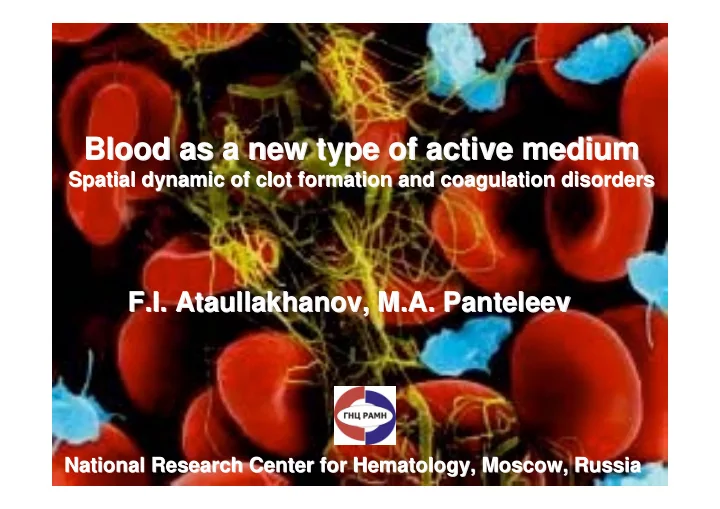

Blood as a new type of active medium Blood as a new type of active medium Spatial dynamic of clot formation and coagulation disorders Spatial dynamic of clot formation and coagulation disorders F.I. Ataullakhanov, , M.A. Panteleev M.A. Panteleev F.I. Ataullakhanov National Research Center for Hematology, Moscow, Russia National Research Center for Hematology, Moscow, Russia
The coagulation cascade: a simplified scheme
Real-time in vivo thrombus formation: confocal microscopy platelets tissue factor fibrin platelets + tissue factor tissue factor + fibrin platelets + fibrin platelets + fibrin + tissue factor Falati et al. Nature Medicine 2002; 8: 1175 - 1181
The problem of complexity ?
The problems of complexity in coagulation: specification 1. More than 50 proteins… 2. Interacting in more than 100 reactions… 3. With each other, with blood cells, vascular cells, and extravascular cells… 4. In the presence of rapid blood flow… 5. And all components are free to diffuse thoughout the vasculature…
Basic hypothesis Complex biochemical systems can be reduced to simpler subsystems, each performing a specific task Such specific tasks for blood coagulation may include: 1) Activation threshold: not to function unless necessary 2) Spatial propagation: to create a 3D clot 3) Termination of propagation: to localize the process and thus avoid thrombosis 4) Coagulation in flow: to function normally or not to function at all.
Objective of the study To identify reactions of the coagulation cascade, which are responsible for the specific tasks
Mathematical model 1. The model is composed of 28 partial differential equations 2. The variables include: active coagulation factors, their inactive precursors, inhibitors, platelets 3. Model parameters were kinetic constants (>100) and concentrations (>40), taken from experimental studies. No adjustment was performed. 4. Conditions: physiological temperature and ionic strength (37ºC, pH 7.2–7.4, 2 �� Ca++, 150 �� NaCl) 5. In order to develop the model, a hierarchy of increasingly complex systems was simulated; comparison with experiment was carried out at each step 6. The final version of the model was tested by comparison with >100 experimental curves obtained under different conditions by several laboratories, including ours
A typical model equation (for a one-dimensional reaction-diffusion system) ] [ ] [ ] [ 2 VIII , IIa F � VIIIa � [ VIIIa ] k � VIII � IIa h VIIIa � [ ] cat = D VIIIa + � VIIIa [ ] 2 VIII , IIa F � + t � x K IIa M Diffusion Production Inhibition
Methods of model analysis 1. Reduction (control analysis, Tikhonov's theorem) 2. Stability analysis 3. Numerical experiments
Task 1: Activation threshold
Final clot density VS activation: model reduction Factor V is activated No factor V activation 7 7 6 6 5 5 Fibrin Fibrin 4 4 3 3 2 2 1 1 0 0 0.00 0.02 0.04 0.06 0.08 0.10 0.12 0.00 0.02 0.04 0.06 0.08 0.10 0.12 Activation Activation ( ) Bx y = Ax = � y A e 1
Final clot density VS activation: the experiment Fibrin clot density (a.u.) 1.0 0.8 0.6 0.4 0.2 0.0 0.00 0.02 0.04 0.06 0.08 Activation (pM of TF)
Activation threshold Activation
Task 2: Spatial propagation IN VITRO T I M E IN VIVO
Hemophilia A Normal The end
Contribution of two pathways to factor X activation: the model Panteleev et al. Biophys J. 2006
Factor X activation in the reaction-diffusion system Factor Xa (nM) Factor Xa (nM) Factor Xa (nM) 0.6 0.6 0.6 0.5 Extrinsic 0.5 0.5 Intrinsic Summary 0.4 0.4 0.4 0.3 0.3 0.3 0.2 0.2 0.2 0.1 0.1 0.1 0.0 0.0 0.0 40 40 40 Time (min) Time (min) ) 30 30 n 30 i m 20 20 20 ( 10 10 e 10 m 0 0 0 i 0.0 0.5 1.0 1.5 2.0 2.5 3.0 T 0.0 0.5 1.0 1.5 2.0 2.5 3.0 0.0 0.5 1.0 1.5 2.0 2.5 3.0 Distance (mm) Distance (mm) Distance (mm) Theory Experiment 2.0 2.0 Factor VIII Clot size (mm) Clot size (mm) 0% 1% 1.5 1.5 5% 10% 20% 1.0 1.0 40% 100% 0.5 0.5 0.0 0.0 0 10 20 30 0 10 20 30 Time (min) Time (min) Panteleev et al. Biophys J. 2006
Spatial propagation Propagation
Task 3: Termination of propagation
Clot localization by thrombumodulin Model Model+Experiment 2.0 Final clot size (mm) 2.0 Control Clot size (mm) 1.5 1.5 10 nM thrombomodulin 1.0 1.0 100 nM thrombomodulin 0.5 0.5 0.0 0.0 0 20 40 60 0 20 40 60 80 100 Time (min) Thrombomodulin (nM) Panteleev et al. Biophys J. 2006
Clot localization by thrombumodulin Panteleev et al. Biophys J. 2006
Termination of propagation Termination
Task 4: Coagulation in flow
Coagulation inhibition by blood flow: the model Normal plasma Factor VII activation by Xa is accelerated 10-fold Lag time (min) 60 Factor VII activation by Xa is slowed down 10-fold 40 20 0 0 100 200 300 400 500 -1 ) Shear rate (min
Coagulation in flow Flow control
Conclusions: decyphering the coagulation cascade Propagation Termination Activation Flow control
Acknowledgements National Research Center for Hematology, Moscow, Russia F.I. Ataullakhanov D.A. Kireev University of Lyon-1, Lyon, France J.V. Krasotkina J.-C. Bordet M.V. Ovanesov C. Negrier M.A. Panteleev V. Volpert A.V. Pokhilko V.I. Sarbash A.M. Shibeko University of Maryland, Baltimore, MD, USA E.I. Sinauridze N.M. Ananyeva A.A. Tokarev E.L. Saenko V.I. Zarnitsina Moscow State University, Moscow, Russia A.N. Balandina A.A. Butylin E.N. Lipets E.S. Lobanova
Recommend
More recommend